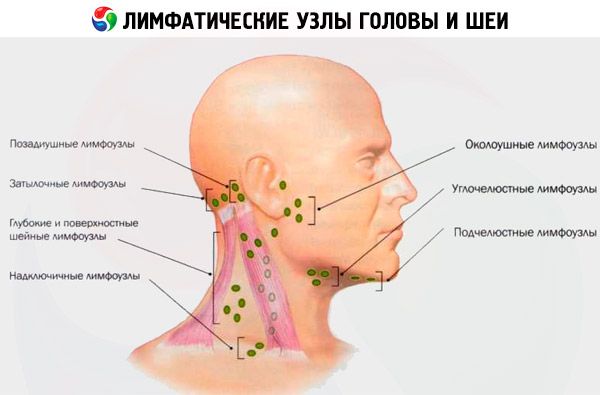Medical expert of the article
New publications
Enlarged occipital lymph nodes in adults and children
Last reviewed: 05.07.2025

All iLive content is medically reviewed or fact checked to ensure as much factual accuracy as possible.
We have strict sourcing guidelines and only link to reputable media sites, academic research institutions and, whenever possible, medically peer reviewed studies. Note that the numbers in parentheses ([1], [2], etc.) are clickable links to these studies.
If you feel that any of our content is inaccurate, out-of-date, or otherwise questionable, please select it and press Ctrl + Enter.

The occipital lymph nodes are located at the back of the neck. When healthy, they are not noticeable at all externally and cannot be felt. However, as a result of the inflammatory process, the occipital lymph nodes enlarge, causing small rounded bumps to appear at the back of the neck, which can become very painful when felt. In some cases, pain occurs even without pressure on the inflamed area - this is a sign of an acute course of the disease.
Causes occipital lymph node enlargement
Lymphadenitis can take a specific or non-specific form. The first type of disorder is a symptom of various severe infectious pathologies. Among them are:
In addition, lymph nodes can become enlarged due to rheumatoid arthritis or leukemia.
The non-specific form of lymphadenitis develops because the infectious focus is located close to the lymph nodes of the occipital part. Their enlargement is usually provoked by such chronic processes as phlegmon, dental caries, tonsillitis or chronic pharyngitis. In addition, otitis or trophic ulcer may be the cause.
Lymphadenitis is sometimes a sign of allergy or, on the contrary, decreased immunity. In some cases, this symptom is observed in cancer patients (in the terminal stage).
The lymph nodes on the back of the head can also become enlarged for the following reasons: rubella, an infectious process in the scalp (with fungi, boils, purulent rashes), and in some cases even because of lice.
Additional causes of increased lymph node enlargement include eczema, streptoderma, or allergic dermatitis.
 [ 3 ]
[ 3 ]
Pathogenesis
Lymph nodes are peripheral organs of the immune system, which consist of various cells and are connected with the blood system by means of efferent and afferent lymphatic vessels, as well as postcapillaries. With the help of fibroblasts, as well as their derivatives (reticular cells), a supporting structure is formed. Histocytes, intraepidermal macrophages and dendrites are very important cells for the body, performing the function of the immune response.

Lymphoid follicles are mostly composed of B cells. Primary lymphoid nodules are populated by B lymphocytes carrying IgM and IgD molecules, as well as T cell helpers, even before the onset of antigen stimulation. Secondary lymphoid nodules are formed as a result of the appearance of an antigen stimulus. They contain a germinal center, which includes active B lymphocytes, mononuclear phagocytes, FDCs, and helpers.
The interfollicular areas, and in addition to them the paracortical areas, are formed mainly from T cells. The joint location of many dendrites, mononuclear phagocytes, lymphocytes and intraepidermal macrophages allows the lymph node to function as the main element of a specific structure that unites these cell types. It is this that forms an effective humoral-cellular immune response of the body.
Lymph nodes can become enlarged due to the following factors:
- an increase in the number of benign mononuclear phagocytes and lymphocytes as a result of the body's immune response to the emerging antigen;
- due to the penetration of inflammatory cells as a result of infections spreading to the lymph nodes;
- proliferation of malignant mononuclear phagocytes and lymphocytes in situ;
- lymph node infiltration by malignant tumor metastases;
- infiltration by mononuclear phagocytes, which are loaded with decay products due to the development of various storage diseases.
Symptoms occipital lymph node enlargement
The skin in the area of the lymph node remains unchanged externally, but the local temperature in this area increases. In addition to unilateral, there is also bilateral enlargement of the lymph nodes in the occipital region. Usually, such a process is accompanied by the following manifestations:
- chills or fever begin, temperature increases;
- symptoms of intoxication occur – loss of appetite, dizziness, severe nausea;
- Due to suppuration, the area around the lymph node becomes red and the skin feels loose when palpated. Pressure causes a throbbing pain and a sharp crunch in the area.
Due to the fact that lymphadenitis is not an independent pathology and manifests itself only as a secondary symptom, in addition to these manifestations, signs of the underlying disease may also be observed, complementing the clinical picture.
Enlargement of the parotid and occipital lymph nodes
The enlargement of the parotid lymph nodes occurs due to the increased load on them. This occurs due to the need to stop and destroy the cells of the emerging tumor or the developing infectious process. In this case, they can be palpated - they are felt as dense nodules of different sizes. In this case, the infection is also fought by the adenoids with tonsils and the thymus gland, which can also increase.
Enlarged occipital lymph nodes in children
In children, the lymph nodes on the back of the head usually enlarge due to various inflammations developing in the scalp (osteomyelitis of the cranial vault, various fungi or furuncles, purulent rashes). An increase in this group of lymph nodes also occurs when a child develops rubella.
Enlarged occipital lymph nodes in adults
Enlargement of the lymph nodes in the occipital region in adults occurs quite rarely (unless due to an infectious process in this area). If this is not observed, the cause is most likely generalized lymphadenopathy (this can occur due to HIV infection).
Complications and consequences
If the patient is not provided with proper and timely treatment, the inflammatory process can develop into generalized sepsis. In this case, toxic substances and infection penetrate the bloodstream, as a result of which they are quickly transported to all cells of the body. This process develops at lightning speed, and the symptoms of the disease increase very quickly.
Since the lymph nodes are close to the brain, their enlargement can result in meningitis. This disease is very serious – it entails many serious complications and in many cases leads to death.
Diagnostics occipital lymph node enlargement
Having detected enlarged lymph nodes, you should immediately consult a doctor. And if the manifestations of the disease increase rapidly, the patient experiences general malaise, and the temperature rises sharply - you should call an ambulance without delay.
Diagnosis of the disease with manifestations of lymphadenitis begins with the procedure of external examination, which is performed by a doctor. She must also collect anamnesis.
Tests
If the nature of the pathology cannot be identified using instrumental methods, doctors prescribe a biopsy of the lymph node enlarged as a result of the disease. Then the contents taken are examined. In addition, blood is taken for analysis.
Instrumental diagnostics
In the absence of such obvious reasons for the increase in lymph nodes as measles or tonsillitis, instrumental diagnostics are performed to determine the provoking factor of the disease. To exclude breast cancer or tuberculosis, an X-ray or fluorography may be required.
What do need to examine?
How to examine?
Who to contact?
Treatment occipital lymph node enlargement
When the occipital lymph nodes are enlarged, it is necessary to treat not the symptom itself, but the underlying disease that provoked it. While waiting for the doctor to arrive, it is recommended to apply a cold compress to the site of inflammation, and also, if necessary, take an analgesic and antipyretic drug. It should be remembered that it is strictly forbidden to heat the lymph nodes, as this can activate the purulent process, which results in the development of a very dangerous complication - sepsis.
Medicines
In the treatment of diseases that cause enlargement of the occipital lymph nodes, drugs of different pharmacological categories are used: anti-inflammatory drugs, antibiotics, as well as immunomodulatory drugs, etc.
Usually, lymph nodes enlarge due to an infectious process that needs to be treated with antibiotics. Using these drugs quickly normalizes their size, eliminating inflammation.
When the cause of the enlargement cannot be determined, doctors prescribe a course of antibiotics (no more than 10 days). If the patient's condition improves and the lymph nodes decrease in size, this is considered a factor confirming the bacterial nature of the pathology.
In cases where the lymph nodes have become enlarged due to an allergic reaction, you need to eliminate any contact with allergens and also start taking antihistamines.
Antibiotics that are actively used at the early stage of the disease are drugs that can slow down the inflammation process. The most effective are the following drugs - Amoxicillin, Flemoxin and Amoxiclav, as well as Ceftazidime, Ceftriaxone and Ampicillin. The treatment course with these drugs lasts about 10-14 days. This is often enough to slow down the inflammation. In parallel with this, the underlying disease is treated.
Surgical treatment
In case of suppuration of lymph nodes, surgical intervention can be performed. The consequences of purulent lymphadenitis are eliminated with the help of operations: abscesses and adenophlegmons are opened, and in addition, pus is removed and wounds are drained.
Forecast
Enlargement of the occipital lymph nodes at the initial stage and with timely correct treatment generally has a favorable prognosis. But if complications arise due to untimely treatment, especially if sepsis has begun to develop, the prognosis worsens, and even a fatal outcome is possible.
 [ 21 ]
[ 21 ]

